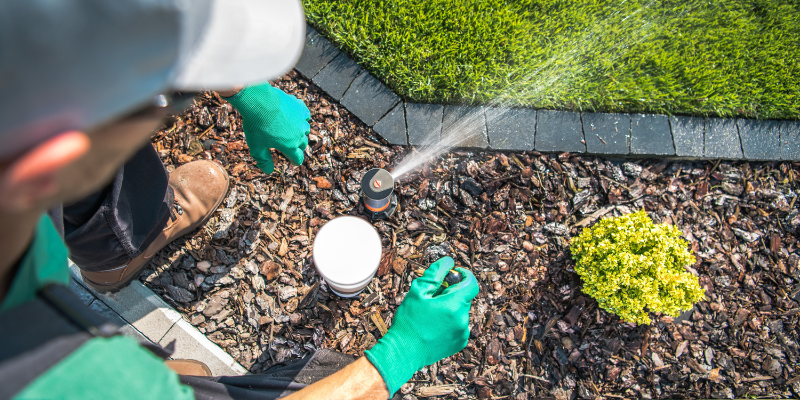
Winterizing your lawn sprinkler system is a seasonal necessity. This process protects the system from freezing temperatures that can cause pipes to crack or burst—a rather costly predicament. Properly preparing your system for winter helps avoid unwanted repairs and ensures it’s ready to go once spring arrives.
In this guide, we’ll address common questions about winterizing your sprinkler system and keeping your irrigation system intact.
Why Is It Important to Winterize My Sprinkler System?
You must winterize your sprinkler and irrigation systems because any water left inside the pipes can freeze, expand, and cause them to crack or burst. Repairing this type of damage can be costly and may result in lawn damage due to excavation. Proper winterization ensures your system is protected throughout the cold months, freeing you from potential headaches and repair bills in the spring.
When Should I Winterize My Sprinkler System?
Timing is everything when it comes to winterizing your sprinkler system. It’s best to perform the process before the first hard freeze, typically in late fall. In Southern Ontario, it’s recommended to begin the winterization process as soon as temperatures start dropping consistently below freezing, usually around mid-October. Waiting too long can expose your system to freezing conditions, increasing the risk of damage.
How Do I Drain My Sprinkler System?
There are three common methods for draining a sprinkler system: manual drain, automatic drain, and blow-out.
- Manual Drain: This method involves opening valves at the lowest points in your system to allow gravity to pull water out of the pipes.
- Automatic Drain: Some systems automatically release water when the pressure falls below a certain level, making winterization easier.
- Blow-Out Method: For complete peace of mind, using compressed air to blow out any remaining water from the pipes is the most effective way to ensure no water remains. However, this method should be done carefully to avoid damaging the system. It’s often best to hire a professional for a blow-out service to ensure it’s done safely and correctly.
Can I Winterize My Sprinkler System on My Own?
While it is possible to winterize your system yourself using the manual drain or automatic drain methods, the blow-out method requires specialized equipment and experience. Attempting to use compressed air without proper knowledge can damage your system, so if you’re unsure, it’s safer to hire a professional. Professionals not only ensure the job is done properly but can also inspect your system for any potential issues that may arise in the spring.
What Happens If I Don’t Winterize My Sprinkler System?
If you neglect to winterize your sprinkler system, any water left in the pipes (and inevitably, there will be some) will freeze and expand as temperatures drop, potentially causing the pipes to burst. This can lead to expensive repairs and the need for extensive excavation work on your lawn. Additionally, valves, sprinkler heads, and other components may also sustain damage, leading to system malfunctions come spring.
What Tools Are Needed for Winterizing a Sprinkler System?
If you’re planning to winterize your system yourself, you’ll need a few key tools, including:
- A wrench to open and close drain valves.
- An air compressor (for blow-out systems).
- An adapter to connect the air compressor to your sprinkler system.
- Safety gear such as goggles and gloves to protect yourself from high-pressure air.
- For a professional-grade blow-out, it’s usually best to hire a qualified contractor who has the appropriate tools and experience to perform the job correctly.
How Does the Blow-Out Method Work?
The blow-out method is the most effective way to ensure that no water is left in your sprinkler system. A professional will use an air compressor to force air through the pipes, blowing out any remaining water. The process must be done carefully to avoid over-pressurizing the system, which can cause damage. Starting at the farthest sprinkler zone and moving toward the compressor, each zone is blown out until all the water is expelled.
How Can I Tell If My Sprinkler System Was Properly Winterized?
After completing the winterization process, it’s important to check that no water remains in the pipes. If you’ve used the blow-out method, ensure that each sprinkler head stops releasing water and that you’ve followed the process for all zones. If you’ve opted for a manual or automatic drain system, inspect each valve to make sure they are fully open and no water is present.
Should I Hire a Professional to Winterize My Sprinkler System?
Hiring a professional to winterize your sprinkler system is often the best option, especially if you’re unfamiliar with the blow-out method. Professionals have the right equipment, knowledge, and experience to ensure the job is done safely and effectively. They can also inspect your system for any potential issues, giving you peace of mind that your system will be ready to function properly in the spring.
Ready to Winterize Your Sprinkler System? Contact Us Today!
Winterizing your sprinkler system is a necessary step in protecting your investment and ensuring it operates smoothly for years to come.
If you’re looking for a reliable and professional service, contact Lawrence Park Complete Garden Care today. Our experts specialize in winterizing sprinkler systems and can help ensure your system is safe from winter damage.